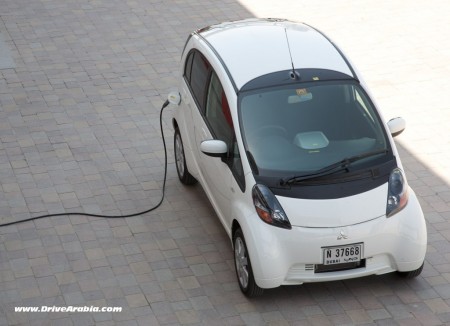First drive: Mitsubishi i-MiEV electric car at Dubai Autodrome

Late last year, on the sidelines of the Mitsubishi ASX crossover launch event at the Dubai Autodrome, Mitsubishi had an egg on four wheels parked outside the halls, plugged into the wall like a blender. We quickly recognised that to be the Mitsubishi i-MiEV, the Japanese firm’s first commercially-available electric car.
The quirky-named Mitsubishi i started life as a petrol-powered “kei car” sold only in Japan, and later it formed the basis for this electric version, dubbed the i-MiEV. It uses a conventional array of batteries, motor and inverter to send power to the rear wheels. The production version debuted in 2009 with a single permanent-magnet synchronous motor mounted on the rear axle with a power output of 47 kW, or 63 hp and 180 Nm of torque. The vehicle uses a single-speed reduction gear transmission and has a 16 kWh lithium-ion battery pack that consists of 88 cells.
The all-electric range is between 120 km and 160 km, with a top speed of 130 kph. Recharging is estimated to take 7 hours from a 220-volt power supply and as little as 30 minutes from a quick-charging station if available.
Mitsubishi had a couple of white Japanese-spec cars in the UAE for hot-weather testing. And Mitsubishi made them available for us to do a couple of laps in at the track.
In a hilarious bit, our photographer wanted to drive first and he ran straight for the left-hand-side door while I resigned myself to being a passenger and went to the right-side door. When we sat inside, the steering wheel was in front of me instead. Indeed, “Japanese-spec” meant right-hand-drive cars.

There isn’t much to look at. The interior is completely bargain-basement, hinting at its economy-car roots. All plastics are rock-hard, the seats were vinyl, and the stereo was an aftermarket-looking piece.
Driving off simply means shifting it into “D” on the P-R-N-D-Eco-B automatic, although we were asked to use “B” on the track instead, whatever that is. The car starts moving, and then, nothing. There is no noise except for the rumble of the tyres and the hush of the wind.
And, that’s about the extent of the track drive. We trundled around the track at speeds never exceeding 80 kph. The suspension seemingly never allowed any body roll, although the driving experience always felt “tall”, largely because we were following another i-MiEV and kept staring at its slim rear end. Road and wind noise is very noticeable though, especially since there is absolutely no engine noise to speak of, for obvious reasons. If you’ve ever driven a golf cart, you’ll have a slight idea of how it felt.

This was the first time we’d ever driven an electric car. With electric cars widely being touted as the future of motoring, all glory seems taken by the Chevy Volt and the Nissan Leaf nowadays, even though the i-MiEV has been on sale since the summer of 2009 in Japan and since October 2010 in Europe, with sales imminent in the United States. However, it will be a while before it becomes the future of motoring here, considering asking prices at the equivalent of Dhs 150,000. However, government incentives reduce the price in countries where it is offered, which won’t happen in the Middle East. So for now, all Mitsubishi can do in the UAE is use this place as a hot-weather test bed.
Event photos by Faisal Khatib.







Comments
ROJ
Ive seen plenty of it in malaysia and singapore.. its an all right plan..
Mashfique Hussain Chowdhury
Pretty sure you saw the petrol version. Malaysia doesn’t seem like the electric type.
BKJ
I really dont think this will sell well, not unless petrol prices rise to be equivilant to countries outside the GCC.
lucid
I think the minority of go-green GCC locals would be more interested in the Tesla. 🙂
A. Basit
This electric version was being displayed at ADNEC World energy summit. I test drove Mercedes A Class Electric car.
Smart electric car was also available for test drive. Mercedes road noice wasnt annoying coz it was very less.
ROJ
I’ve seen a petrol version being used as a project car.. Fine tuned for road and occasional track use..
Abdullah
Although the design is ugly, and the engine is a toy … this car should be introduced to the Middle East …
At least for people to get to know how green electrical energy is … and this can be a step towards convencing them to buy Hybrids …
Our cities are the most poluted in the world … We are breathing sand due to the crazy amount of constructions going around … and we top it up with our cars’ emissions …
We need electrical cars … hybrids are there if you want performance … BUT … FOR THIS WE NEED THE “QUICK CHARGING STATIONS” EVERYWHERE IN THE CITIES … WOULD TAKE AS YEARS TO ACCOMPLISH THIS … THIS IS NOT THE MARKET FOR THIS CAR …
A. Basit
^ This one will be used in the Masdar city for transportation.
Azim
How much does it cost in countries where it is sold? It looks like tata’s Nano…it sudm’t cost more than 50,000 Dhs
A. Basit
it costs approximately 130,000 Dhs. its expensive because of high cost of the battery.
XYZ
it seems look pretty good what benifit a normal people get an advantage with this any how the cost is high